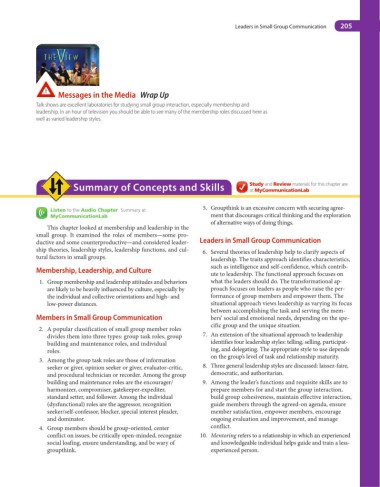Page 226 - Essentials of Human Communication
P. 226
Leaders in Small Group Communication 205
Messages in the Media Wrap Up
Talk shows are excellent laboratories for studying small group interaction, especially membership and
leadership. In an hour of television you should be able to see many of the membership roles discussed here as
well as varied leadership styles.
summary of Concepts and skills Study and Review materials for this chapter are
at MyCommunicationLab
5. Groupthink is an excessive concern with securing agree-
Listen to the Audio Chapter Summary at
MyCommunicationLab ment that discourages critical thinking and the exploration
of alternative ways of doing things.
This chapter looked at membership and leadership in the
small group. It examined the roles of members—some pro-
ductive and some counterproductive—and considered leader- leaders in small Group Communication
ship theories, leadership styles, leadership functions, and cul- 6. Several theories of leadership help to clarify aspects of
tural factors in small groups. leadership. The traits approach identifies characteristics,
such as intelligence and self-confidence, which contrib-
Membership, leadership, and Culture ute to leadership. The functional approach focuses on
1. Group membership and leadership attitudes and behaviors what the leaders should do. The transformational ap-
are likely to be heavily influenced by culture, especially by proach focuses on leaders as people who raise the per-
the individual and collective orientations and high- and formance of group members and empower them. The
low-power distances. situational approach views leadership as varying its focus
between accomplishing the task and serving the mem-
Members in small Group Communication bers’ social and emotional needs, depending on the spe-
cific group and the unique situation.
2. A popular classification of small group member roles
divides them into three types: group task roles, group 7. An extension of the situational approach to leadership
building and maintenance roles, and individual identifies four leadership styles: telling, selling, participat-
roles. ing, and delegating. The appropriate style to use depends
3. Among the group task roles are those of information on the group’s level of task and relationship maturity.
seeker or giver, opinion seeker or giver, evaluator-critic, 8. Three general leadership styles are discussed: laissez-faire,
and procedural technician or recorder. Among the group democratic, and authoritarian.
building and maintenance roles are the encourager/ 9. Among the leader’s functions and requisite skills are to
harmonizer, compromiser, gatekeeper-expediter, prepare members for and start the group interaction,
standard setter, and follower. Among the individual build group cohesiveness, maintain effective interaction,
(dysfunctional) roles are the aggressor, recognition guide members through the agreed-on agenda, ensure
seeker/self-confessor, blocker, special interest pleader, member satisfaction, empower members, encourage
and dominator. ongoing evaluation and improvement, and manage
4. Group members should be group-oriented, center conflict.
conflict on issues, be critically open-minded, recognize 10. Mentoring refers to a relationship in which an experienced
social loafing, ensure understanding, and be wary of and knowledgeable individual helps guide and train a less-
groupthink. experienced person.

